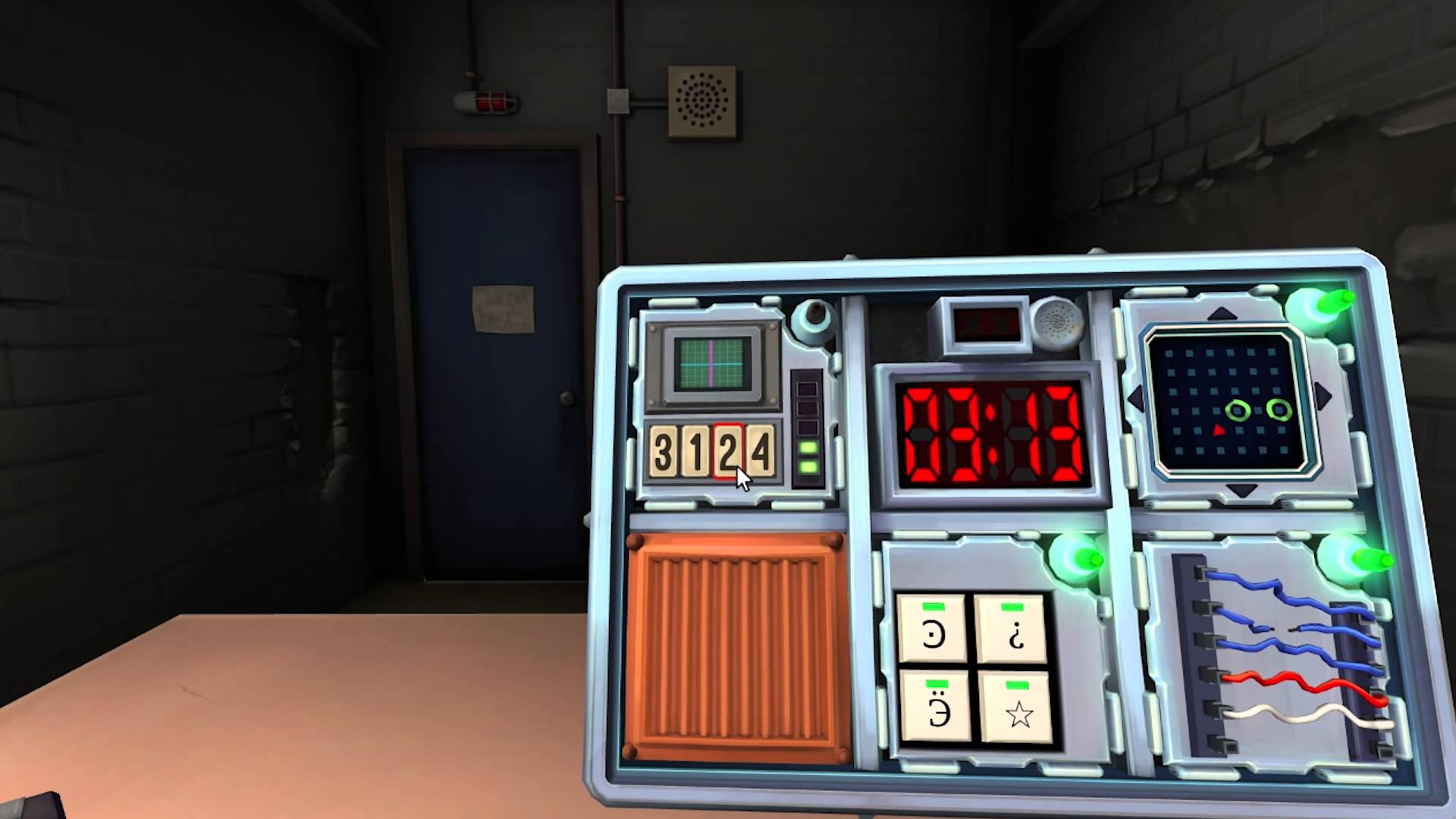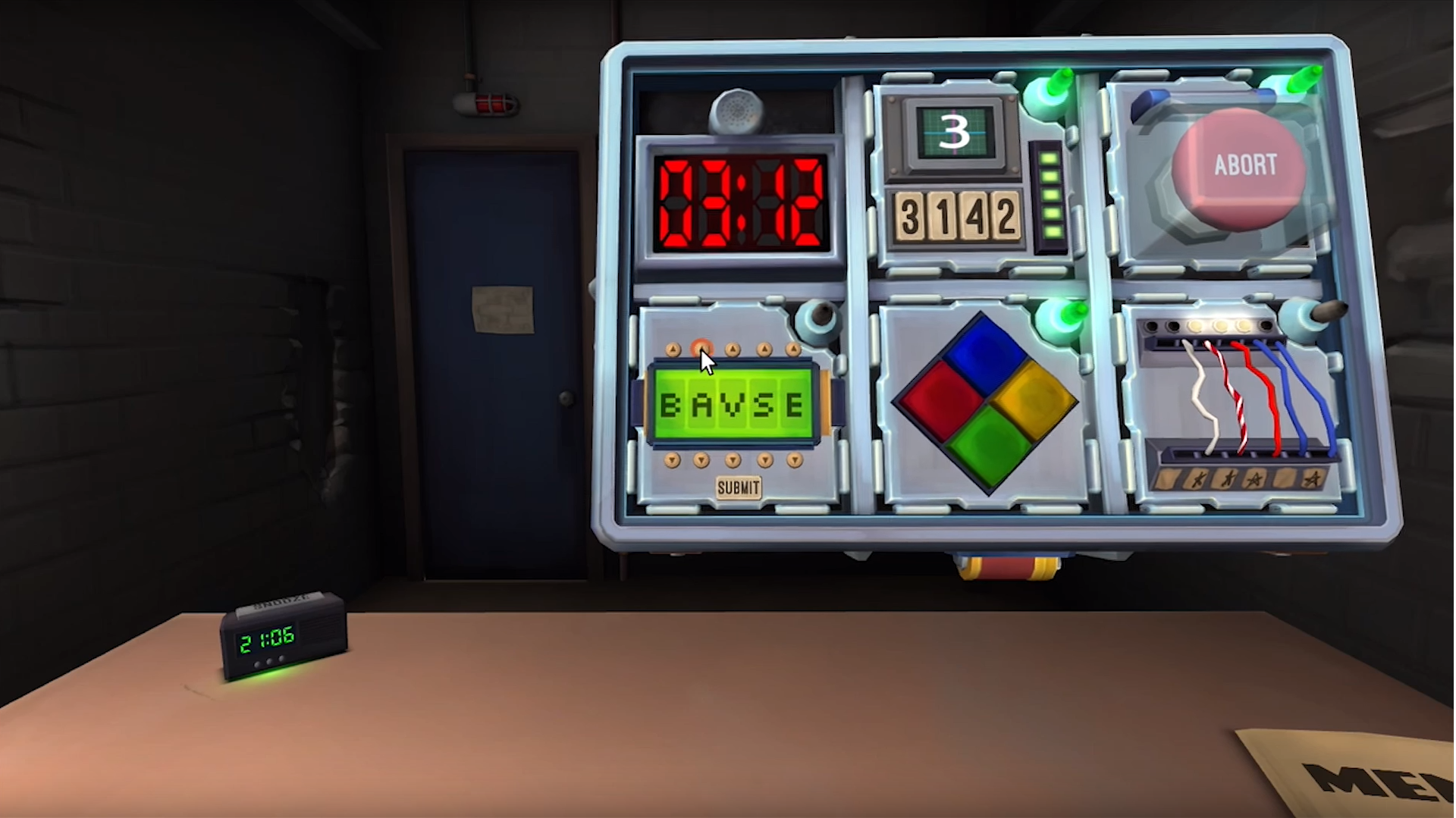Search
[{{{type}}}] {{{reason}}}
{{/data.error.root_cause}}{{{_source.title}}} {{#_source.showPrice}} {{{_source.displayPrice}}} {{/_source.showPrice}}
{{#_source.showLink}} {{/_source.showLink}} {{#_source.showDate}}{{{_source.displayDate}}}
{{/_source.showDate}}{{{_source.description}}}
{{#_source.additionalInfo}}{{#_source.additionalFields}} {{#title}} {{{label}}}: {{{title}}} {{/title}} {{/_source.additionalFields}}
{{/_source.additionalInfo}}- Details
- Category: Computer
- By Sam George
- Hits: 5557
Keep Talking and Nobody Explodes (PC)

Keep Talking and Nobody Explodes
Developed by: Steel Crate Games
Published by: Steel Crate Games
Released: October 8, 2015
Available On: Windows, macOS, PlayStation 4, HTC Vive, Oculus Rift, OSVR
ESRB Rating: Not Rated
Genre: Puzzle
Number of Players: 2 or more
Mode: Local co-op
Price: $14.99
(Humble Store Link)
“Hello, this is the bomb defusal hotline; how may we assist you today?” This was my friend Bob (all names changed). Over the speaker phone we heard Sara’s answer: “Hi, I seem to be locked in a room with a bomb.” She was down the hall with my laptop, a phone, and no idea what to do.
“I’m sorry to hear that,” I said. “Could you describe the bomb, please?” Bob and I had no idea what we were doing, either. This was our first time playing Keep Talking and Nobody Explodes. In the next five minutes we would experience the stress of communication troubles, logic puzzles, and a pressing timer. With five seconds left, we also felt the thrill of triumph. The bomb was defused; Sara was saved.
Keep Talking and Nobody Explodes is a cooperative PC game in which one player, the Defuser, is stuck in a virtual room with a bomb on a timer. The rest of the players, called the Experts, have a manual; inside are instructions for defusing the bomb. The Defuser can’t look at the manual, and the Experts can’t look at the bomb. They all have to keep talking to save the Defuser from a digital explosion.
This game requires different resources than the average PC multiplayer setup. There is no single-player mode. Players need a computer for the Defuser, a way to communicate with the Experts, and a manual. My first game used a phone, but players can just as easily sit in the same room as long as the Experts keep their eyes off the computer screen. The manual is available for viewing and download from http://www.bombmanual.com/. I recommend printing for the best experience. While the manual can be viewed on a phone or tablet, a paper copy allows faster page flipping and note taking, tasks essential to the Experts’ role. There is a VR version of the game and manual available via Oculus Rift, HTC Vive, OSVR, and PS VR. Although I have not had the opportunity to try the VR experience, gameplay is identical in all versions.

Strong Points: Team/communication skill building; short levels mean mistakes don’t hurt for long; only one copy needed for multiplayer; simple controls
Weak Points: Brief overall; no single-playe moder; repetitive without resorting to community-made levels; puzzles are less challenging once players become familiar with the game
Moral Warnings: Centered on bombs; within the world of the game, the player, not the character, "dies" when you lose
The bomb can have anywhere from three to eleven separate modules that need solving. They range from the basic—a yellow button labeled "Disarm"—to the complex—a maze with invisible walls. There are wires, passwords, symbols, Morse code, and more. Each module has a corresponding page in the manual. The Defuser might see a box with five wires. Which should be cut? Only the Experts can answer, using the page titled “On the Subject of Wires.” As the Defuser describes the bomb and Experts figure out what to do, time leaks away. If the players make a mistake such as cutting the wrong wire, they get a strike, and the timer ticks down faster. If the timer hits zero or the Defuser gets three strikes, the bomb explodes.
At its heart, this is a game about communication. The Defuser describes what he sees, and the Experts give instructions. The manual is filled with mini logic puzzles such as, “If there are no yellow wires and the last digit of the serial number is odd, cut the third wire.” The manual is clever and obtuse. "On the Subject of Complex Wires" features the most convoluted Venn diagram I've ever had to use. "On the Subject of Who's on First" exploits homophones to great effect. Generally, the puzzles would be trivial if one could see the bomb and the manual. The fun is in the division of information between the two groups. For example, one module is a keypad with four random symbols. It is the Defuser’s job to make the Expert see the symbols without looking at them.
Defuser: “I see a weird six, a spider with a shield, a smiley face, and an X on an I.”
Expert: “Wait, an Eye?”
Defuser: “No, an I.”
Gameplay is tense. Everyone can hear the timer beeping away, and it prevents players from being entirely certain they are making the right move. You will get lots of laughs from Defusers pressing the wrong button, Experts making simple mistakes, and everybody deciding it's just time to pick a wire and hope. Even when things are going well, you feel the race against the clock. Every successful defusal is a rush.
Upon playing, you will likely learn how the other players communicate, think, and act under pressure. You will certainly have fun. It is everything office team-building exercises want to be, and levels average only five minutes. Gameplay is inherently rewarding and might forge new friendships. Though there is one Defuser, there can be as many Experts as you want. Keep Talking, which naturally draws people in (how often do you hear someone shout, “Cut the red wire”?), can easily expand to about five players.

Higher is better
(10/10 is perfect)
Game Score - 84%
Gameplay - 16/20
Graphics - 8/10
Sound - 8/10
Stability - 5/5
Controls - 5/5
Morality Score - 94%
Violence - 7/10
Language - 10/10
Sexual Content - 10/10
Occult/Supernatural - 10/10
Cultural/Moral/Ethical - 10/10
There is no story here unless the players role-play. The tutorial is a two-minute affair which teaches how to use the mouse to interact with the bomb. The controls are easy and responsive, and this tutorial pulls off the difficult feat of teaching people who are not used to three digital dimensions how to rotate the bomb. The graphics are modest, making the information on the bomb easy to parse. When I play in a public area, I make a habit of asking random passers-by if they have five free minutes. Almost anyone who plays can manage the controls and understand the manual. Keep Talking takes the uninitiated and turns them into competent players in minutes. It’s a great party game.
Simplicity is a strength and a weakness, however. There are few levels and limited modules. Every level is randomized each time you play, but all randomization takes place within the confines of the manual. Over time, players develop codes and procedures for modules. The Defuser rattles off the information he knows the Expert needs; then he just waits for an answer. In short, the more proficient players become at communicating within the game, the fewer surprises and laughs the game can offer.
Don’t let that stop you from trying this game out. The Steam Workshop has additional modules and manuals which players have added to the base game, should you want to mod it. If not, the solution to rote play is bringing on fresh players and mixing up the roles. The fun will return when the newcomer says, “There’s an abort button. I’m pressing it.”
If the premise of the game is not a moral concern, nothing else about it will be, either. The “explosion” is limited to a stock sound and the screen turning black. The game takes place in a small room that shows slight damage from previous explosions. The game is first-person; it is you, not some character, who explodes when you lose. There is music typical of a spy thriller that slowly builds as the timer counts down. Stress builds, too, and it can cause conflicts amongst the players if they let it. Then again, so can office team-building exercises.
I highly recommend Keep Talking and Nobody Explodes. The price is reasonable for the fun you can have as a group. The game is lightweight and can run on a laptop. If you are close to anyone who hasn’t tried a video game before, buy this game and ask for five minutes of their time. You will be glad you did.








